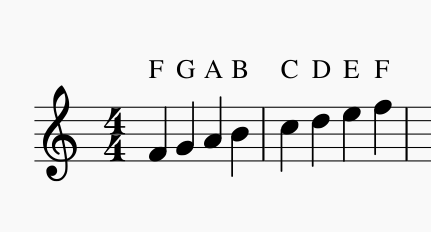

In practice, a MIDI software can label middle C (261.626 Hz) as C 3–C 5, which can cause confusion, especially for beginners. Treble C, Tenor High C (written an octave higher for tenor voices), 1' Organ Pipesįor a classical piano and musical theory, the middle C is usually labelled as C 4 However, in the MIDI standard definition (like the one used in Apple's GarageBand), this middle C (261.626 Hz) is labelled C 3. Low C, cello C, 8' C (see organ pipe length)Ĥ' C or Tenor C (organ), viola C, Tenor Middle C (Tenor Voice) Triple Low C (32' Organ Pipes), Octobass Cĭouble Low C (16' Organ Pipes), (Double Bass w/ either Low C Extension, 5 Strings, or in 5ths Tuning)
#Note c in music full
In older stoplists it usually means that a rank was not yet full compass, omitting the bottom octave, until that octave was added later on.ĭesignation by octave Scientific designation Tenor C is an organ builder's term for small C or C 3 (130.813 Hz), the note one octave below Middle C. The term Low C is sometimes used in vocal music to refer to C 2 because this is considered the divide between true basses and bass-baritones: a basso can sing this note easily, whereas other male voices, including bass-baritones, typically cannot. In vocal music, the term High C (sometimes called Top C ) can refer to either the soprano's C 6 (1046.502 Hz c′′′ in Helmholtz notation) or the tenor's C 5 both are written as the C two ledger lines above the treble clef but the tenor voice sings an octave lower. Alternatively, it is written on the centre line of a staff using the alto clef, or on the fourth line from the bottom, or the second line from the top, of staves using the tenor clef. On the Grand Staff, Middle C is notated with a ledger line above the top line of the bass staff or below the bottom line of the treble staff. This technically inaccurate practice has led some pedagogues to encourage standardizing on C 4 as the definitive Middle C in instructional materials across all instruments. C 4 may be called Low C by someone playing a Western concert flute, which has a higher and narrower playing range than the piano, while C 5 (523.251 Hz) would be Middle C. While the expression Middle C is generally clear across instruments and clefs, some musicians naturally use the term to refer to the C note in the middle of their specific instrument's range. Middle C (the fourth C key from left on a standard 88-key piano keyboard) is designated C 4 in scientific pitch notation, and c′ in Helmholtz pitch notation it is note number 60 in MIDI notation. A movement to restore the older A435 standard has used the banners "Verdi tuning", "philosophical pitch" or the easily confused scientific pitch. After the A440 pitch standard was adopted by musicians, the Acoustical Society of America published new frequency tables for scientific use. Scientific pitch was originally proposed in 1713 by French physicist Joseph Sauveur and based on the numerically convenient frequency of 256 Hz for middle C, all C's being powers of two. Major scales Here is the C major scale: Keyboard C D E F G A B C (The little dots show where these notes can be found on a piano keyboard.) Most people tend to hear major scales as 'happy' or 'bright.

For an instrument in equal temperament tuned to the A440 pitch standard widely adopted in 1939, middle C has a frequency around 261.63 Hz (for other notes see piano key frequencies). In English the term Do is used interchangeably with C only by adherents of fixed Do solfège in the movable Do system Do refers to the tonic of the prevailing key.

It has enharmonic equivalents of B ♯ and D. The actual frequency has depended on historical pitch standards, and for transposing instruments a distinction is made between written and sounding or concert pitch. For the fruit-flavored drink, see Hi-C.Ĭ or Do is the first note and semitone of the C major scale, the third note of the A minor scale (the relative minor of C major), and the fourth note (G, A, B, C) of the Guidonian hand, commonly pitched around 261.63 Hz. Get UNLIMITED ACCESS to every printable resource on MakingMusicFun."High C" redirects here.Then complete this worksheet by naming each note correctly, and by coloring each note the same color as it was colored at the top of the worksheet. Color each of the first 5 whole notes with a different color. Grab your crayons and color your way to success! Complete this music theory worksheet by first choosing 5 crayons. Color That Note | Note Name Worksheet - Bass Clef/Middle C Position


 0 kommentar(er)
0 kommentar(er)
